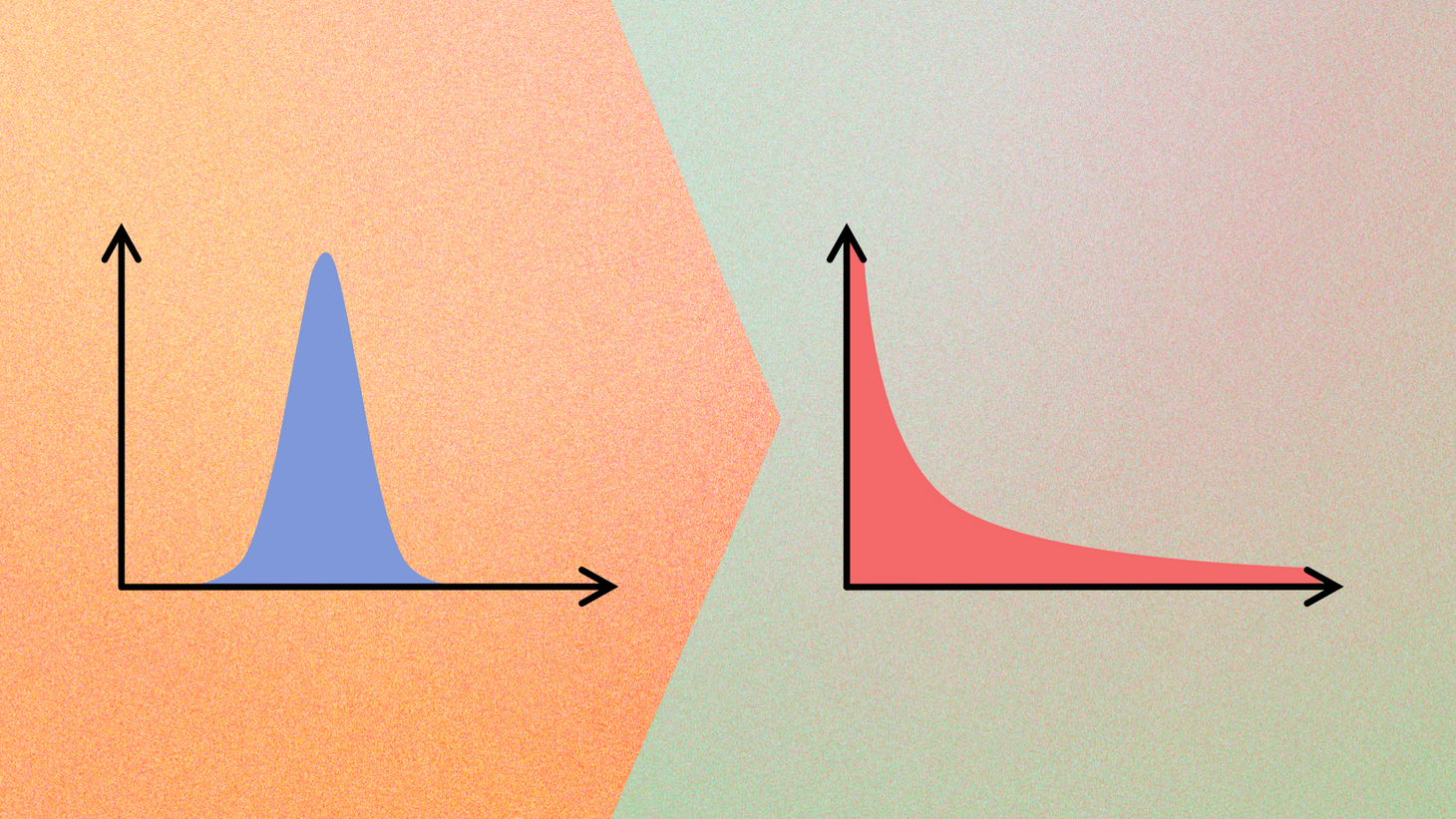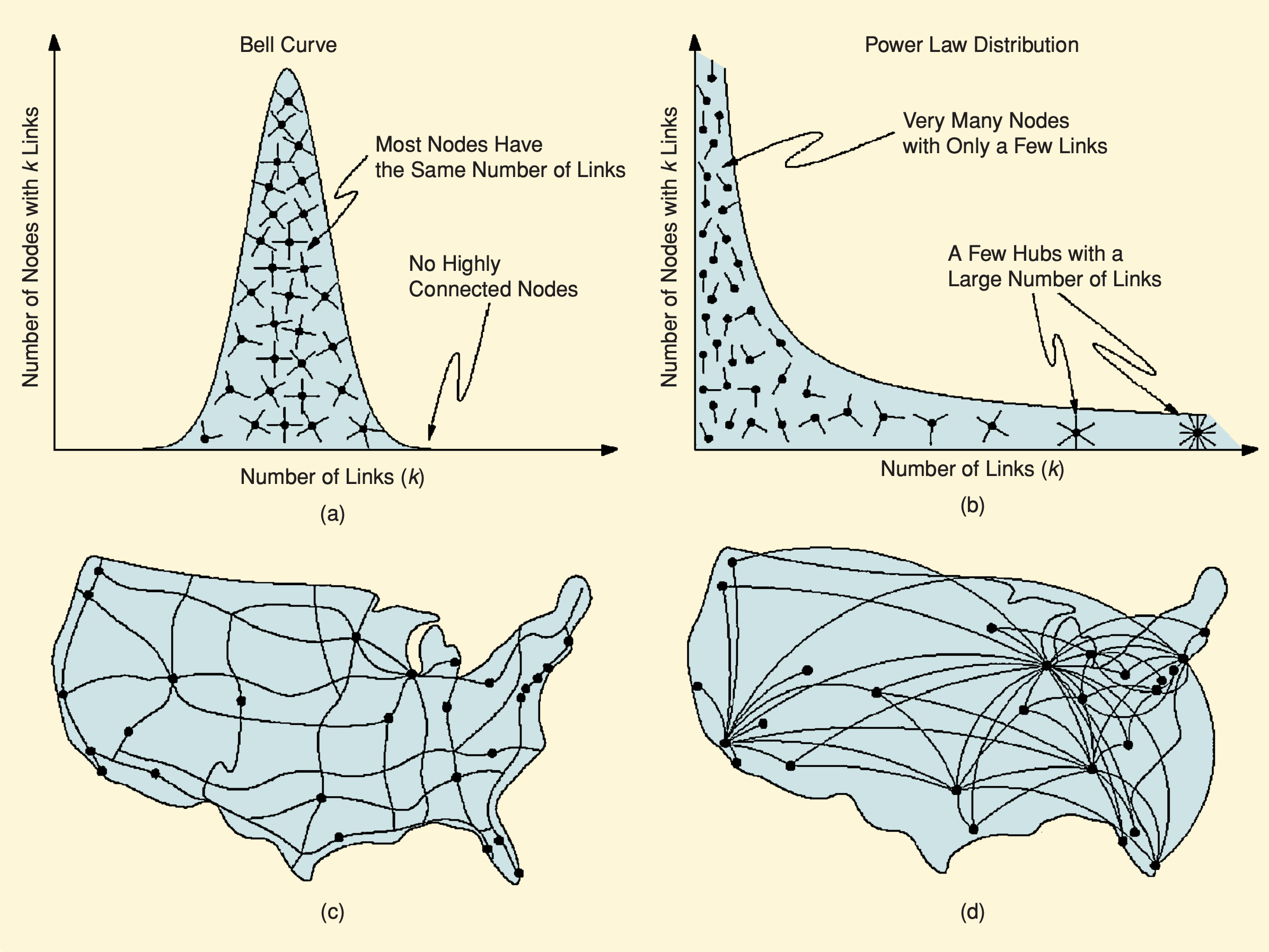Why Inequality is Efficient
The physical and cultural constraints that gave rise to a normal income distribution are losing their power. The difference between highway and airline networks explains why.

🎤 Can offices become housing? Next month, I'm hosting a live conversation with Gensler's Steven Paynter to discuss his analysis of more than 300 potential conversions. Sign up on LinkedIn here. It's free.
🎧 An audio version of this article is available below and on Spotify, Apple Podcasts, and beyond.
Most of the debate around inequality is focused on policy failures of various kinds — access to education, taxation, discrimination, and more. But beyond these, rising inequality is driven by technological change. I have extensively written about it in The New York Times and my newsletter and discussed it in my two podcasts with Scott Galloway (here and here).
I recently came across a theory that explains the essence of this technological change. By focusing on it, I do not mean to absolve or dismiss policy failures or to argue that we should simply learn to live with extreme inequality. I am working on a longer piece about potential policy solutions and approaches (subscribe, so you don't miss it). It is time for some creative and bold initiatives, but first, let's get to the heart of the problem.
A Tale of Two Networks
The charts below are from a 2007 paper by the physicist and network scientist Albert-László Barabási.

The charts compare the network of highways and the network of direct flights between U.S. cities. Cities are represented by nodes (circles), and highways or direct airline connections are represented by links (lines). The chart and map on the left focus on the highway network, and those on the right focus on the flight network.
The two bottom maps show the number of links connected to each node. In the parlance of network science, this number is called a node's "degree." For example, Miami is connected by one highway and three direct flight lines, so its degree on the highway network is one and on the flight network is 3.
The two top charts plot the "degree distribution" for each network. The degree distribution is the probability of degrees across the web. You'll notice degrees of the nodes in the highway network have a bell-shaped or normal distribution (upper left corner). This means that most nodes/cities have a similar number of highway connections and that few cities have a bit more or a bit less. This is evident by looking at the map. Most cities have 2-4 links, while a handful has less than two or more than 4.
Assuming that links are beneficial, we can say that the highway network provides a relatively egalitarian distribution of benefits: most cities have the same number of connections, and the most connected cities are not too far ahead from the average and bottom ones. Another way to describe it is that roughly 80% of the cities get 80% of the links.
Now let's look at the degree distribution of the flight network. As you can see in the upper right corner, the shape of this distribution is very different. It is a power-law distribution, not a normal one. This means most nodes have a small number (1 to 3) of direct flight connections, while a couple of massive hubs like Chicago and Los Angeles have more than ten or even 20 connections.
Assuming again that links are beneficial, we can say that the airline network is extremely unequal: most cities have a few connections, but a tiny minority of cities are far more connected than all the others. Another way to describe it is that less than 10% of the cities get around 50% of the links.
You can already tell there's a lesson here about income distribution. But before we get to that, we have another important question to examine.
Built-In Bias
Why are highway connections normally distributed while airline connections are power-law distributed?
To answer this question, let's consider how each network was created. The airline network evolved relatively organically, with relatively few constraints. An airplane can fly in any direction and to a different place daily. It does not need a static highway; it only needs a place to land — and the same landing strip can accept planes coming from different directions.
This means airlines have relatively fewer constraints when deciding where to fly. Airlines can alter their network over time based on whatever makes the most sense. With so much choice, how do you choose where to fly?
As Barabási explains in the paper mentioned above, networks grow by following two rules:
- They start somewhere; and
- They expand based on specific preferences.
What does this mean in practice? Let's start with the second rule. Imagine you're a business(wo)man launching a new airline. You look at a map of the world and need to decide which two cities you'd like your first line to service. Which cities would you choose?
If you're economically rational, you want to go where the customers are. You're most likely to choose to fly between two cities that already have connecting flights to other destinations, or you'll choose to connect a relatively large hub with a new and attractive destination. One thing is certain: You are much less likely to choose to connect two cities that have no other flights to anywhere else.
Barabási calls this "preferential attachment" — the process by which new connections are added to a network based on a specific preference (as opposed to random luck). In the example above, the preference is "I would like to connect with a node that already has links to other nodes."
Assuming again that links are beneficial, we can say that networks expand in a way that is biased in favor of the already well-connected nodes. New links are more likely to go to those who are already better connected. The "rich" nodes get "richer," while everyone else gets relatively less — and are likely to get even less as the network grows.
The first rule (networks start somewhere) also contributes to this dynamic. The first few nodes in a network are much more likely to become "richer" because they get the first few links. As the network grows, new nodes are more likely to link to nodes that have existing links.
This dynamic applies even when nodes are not conscious or intelligent. And in some types of networks, it gets even worse: new links are not just more likely to "enrich" already-connected nodes; they must do so. We'll discuss these types of networks at another time. For now, all you need to remember is that when they're allowed to, networks grow in a way that favors existing winners.
This leaves us with an open question: If networks evolve to create inequality, why is the highway network so egalitarian?
Equality and Constraints
The airline network is characterized by an abundance of options, dynamism, relative lack of constraints, and relatively organic evolution over a long period.
The highway network is almost exactly the opposite.
It is constrained: Highways are expensive to build and are only feasible in certain situations. This limits the number of highways being built and the number of locations that the network can cover.
It is static: Once a highway is built, it cannot be "rerouted" in another direction.
It did not evolve organically: In the U.S., most of the highway network was planned and enacted during two legislative bursts in the 1930s and 1950s.
Let's unpack the implications of each of these points, starting with the last one. The highway network did not grow organically and did not follow preferential attachment. It took time to build, but the main links were already planned in advance. And those links were chosen by government planners in order to meet a specific agenda (connecting military bases and ensuring all main cities are connected).
Path dependencies made it hard for new nodes to pull ahead and difficult for old nodes to fall behind. Once the initial network was in place, it was almost impossible to change it. While new nodes were added, old nodes remained connected even once their economic importance waned. This means that competition between nodes is relatively limited: A highway to a new city does not eliminate an older highway to an older city. (In contrast, when airlines launch a new link, they often reallocate planes that served other destinations).
And then there's the basic constraint of physical highways: They take up a lot of space. A single airport can link a city directly to hundreds of destinations. But if you try to connect 20 highways directly into a city, you won't have any space left for actual houses and offices.
Based on the above, it's easy to see why the highway network is so "normal." It was designed to serve specific goals. It cannot adapt to cater to changing preferences. And its physical constraints make it impossible for any one node to accumulate too many links. These constraints and limitations make severe inequality impossible.
Ok. Now we understand why the highway network is egalitarian while the airline network is unequal. But what does all this have to do with income inequality?
Industrial Scarcity
The highway network was the nervous system of America's industrial machine. It was built to accommodate the main products (automobiles) that were made by the largest employers in the largest economy of the 20th Century.
Normal distributions were endemic in the industrial world. Most cities enjoyed the same level of connectivity—most people in most professions earned within the same range of salary. A broad middle class consumed identical, mass-produced goods that were marketed through a handful of mass-media channels. The above world only existed for a few decades, but we still consider it "normal" — and consider anything that happened after it as some sort of historical aberration.
What made the industrial world so "normal"?
The same characteristics that made the highway network's degree distribution normal.
Companies in the industrial economy were constrained: They could not produce whatever they wanted, whenever they wanted. Every product required specific machines that were expensive to build and install. This compelled companies (and whole industries) to mass-produce a relatively small number of relatively identical goods. And even the largest companies could only service a limited number of customers (due to shipping costs and trade barriers).
Markets in the industrial economy were relatively static: Once companies decided what to produce, it was difficult to change course. Replacing or reconfiguring all the relevant machines and workflows was costly and time-consuming.
Workflows in the industrial economy did not evolve organically: Companies were centralized, and production and hiring decisions were made from the top down.
The industrial economy was defined by scarcity: The key to success was controlling supply rather than controlling demand. Output was a linear function of input — the more capital, labor, and material you put in, the more widgets you got to produce and sell. Work was typified by large groups of equally-trained employees doing relatively identical tasks and earning more or less the same.
Thinking of the industrial labor market as a network highlights what made it so egalitarian. Each employee could only connect to a handful of nearby employers and sell their services within a relatively small and static market. Once you chose your "profession," it was costly and difficult to change course. Once you were employed, it was expensive and challenging to switch firms. Offices forced the best performers to waste time on meetings and commutes. People who could not conform to office-based 9-to-5 work were left out of the labor market. And regardless of one's energy and initiative, promotions were slow and pre-ordained. It was hard to "cut the line" or for any paths other than the one set by the largest employers.
The industrial labor market had many of the characteristics of the industrial highway system. It is unsurprising that its constraints, path dependencies, lack of dynamism, and rigid controls resulted in a normal and relatively egalitarian income distribution.
This brings us back to 2022. Our own labor market still has many industrial strongholds, but it is gradually becoming exactly the opposite. Work is becoming more flexible, more creative, more inclusive, and less linear. The physical and cultural constraints that gave rise to a normal income distribution are losing their power.
More on this soon. Subscribe, so you don't miss it, and follow me on Twitter for something to nibble on in the meantime.
Dror Poleg Newsletter
Join the newsletter to receive the latest updates in your inbox.




